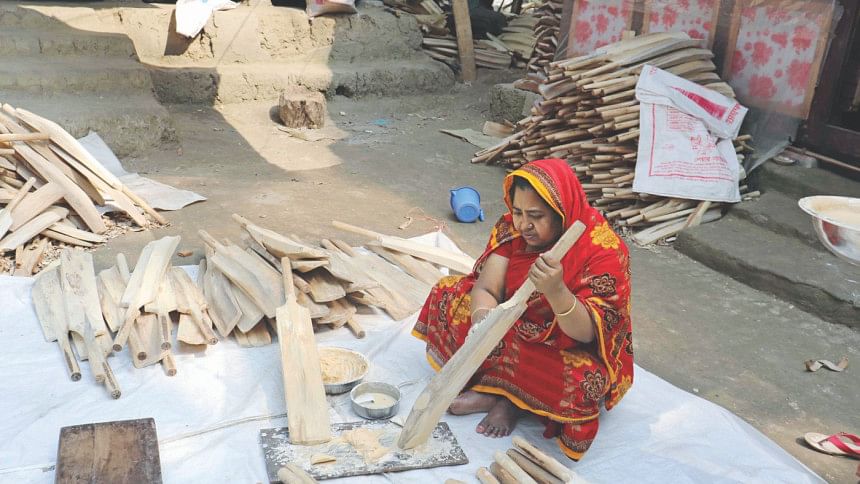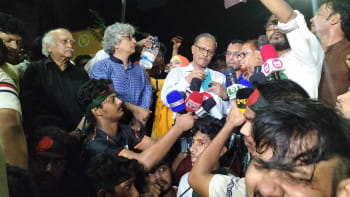Cashing in on cricket mania
Cricket is close to religion in the Indian subcontinent, it is often said.
Bangladesh was late to the party, but thanks to the exploits of Shakib Al Hasan, Tamim Iqbal, Mushfiqur Rahim and Mashrafe bin Mortaza over the past decade the fervour for the game is reaching the same levels as its neighbours.
When love for the sport began to spread countrywide, a carpenter from a remote village in Pirojpur's Nesarabad upazila cashed in on the fervour.
Abdul Latif Bepary, who passed away in 2012, was said to be the country's first carpenter to produce cricket bats.
Born at Uribuniya village on the bank of river Belua, Bepary travelled to Dhaka for work in the 1980s. There, he was introduced to Sirajul Islam Khan, owner of the Khelarsathi sports shop in the capital's Gulistan area.
Under Khelarsathi's employment, Bepary made assorted sporting goods, mainly wooden awards, with great skill.
"One day, the shop owner called in Bepary and showed him some cricket bats imported from Pakistan. He asked if he could replicate it," said Abul Kalam, 59, a relative of Bepary, who owns a cricket bat factory at Binna village in the upazila.

As the specific tree logs required to make cricket bats were not available in Dhaka at the time, Bepary returned to his village where the wood was available.
After that, he began to craft cricket bats for commercial purposes in 1992. The bats were sent to Khan's shop in Dhaka, where they would be sold regularly.
Following Bepary's example, a cottage industry of 200 has sprouted in Nesarabad that is minting Tk 15 crore every year.
The factories can be found at the Uribuniya, Binna, Khejurbari, Jilbari and Katakhali villages under Balodia union, said local businessmen.
According to various cricket bat producers, the business began to spread widely in Nesarabad upazila from 1997, after Bangladesh won the ICC Trophy, the qualification tournament for the 1999 Cricket World Cup, in Malaysia.
Following Bangladesh's victory, the demand for cricket bats rose suddenly as did the people's love for cricket, they said.
To make cricket bats, ideally light wooden logs are needed. In Bangladesh's case, the most suitable wood for the purpose was Gewa wood, which is found in the Sundarbans.

At first, the logs were widely used but after the government banned the cutting of Gewa trees in the mangrove forest, producers switched to kadam (burflower-tree) and hog plum logs, which are very low in quality.
Generally, bats of nine different sizes are made. The prices range from Tk 200-250 depending on size, said Maksudur Rahman, owner of a cricket bat factory at Jilbari village.
The production of cricket bats has created working opportunities for more than 2,000 people, both male and female, in the upazila, said Mizanur Rahman, who owns another factory in the village.
Factories produce anywhere from 10,000 to 100,000 cricket bats each season, which is a six-month period beginning in November, according to Rahman.
The cricket bats made in Nesarabad are sold at almost every corner of the country.
Initially, producers would send incomplete cricket bats to Dhaka, where they would be burnished and decorated for sale. Now, the entire process is handled by the local factories.
These days, workers use the bat's frames using different types of motorised machines. Previously, they would have to do all the work by hand as electricity was not available in the area before 2000.
The industry has provided job opportunities for hundreds of people in Nesarabad. With many having mastered the technique of cricket bat making, new factories are opening up often.
Women have also benefitted as the factories provide a source of income. It is now commonplace to see women put the finishing touches on the bats, such as the burnish and logos.
Women working at the factories earn between Tk 200-250, said Runu Begum of Jilbari village.
"This helps them support their families."
However, businessmen have conceded that using poor quality wood has led to the production of lesser quality bats.
"We have the capacity to make high quality or even international standard cricket bats," said Md Mostofa Kamal, an owner of a bat factory at Jilbari village.
But for want of quality willow, they are unable to do so.
To get higher quality logs, the government needs to lend its support.
"Only then will the factories be able to produce high-standard bats," he added.

 For all latest news, follow The Daily Star's Google News channel.
For all latest news, follow The Daily Star's Google News channel. 



Comments